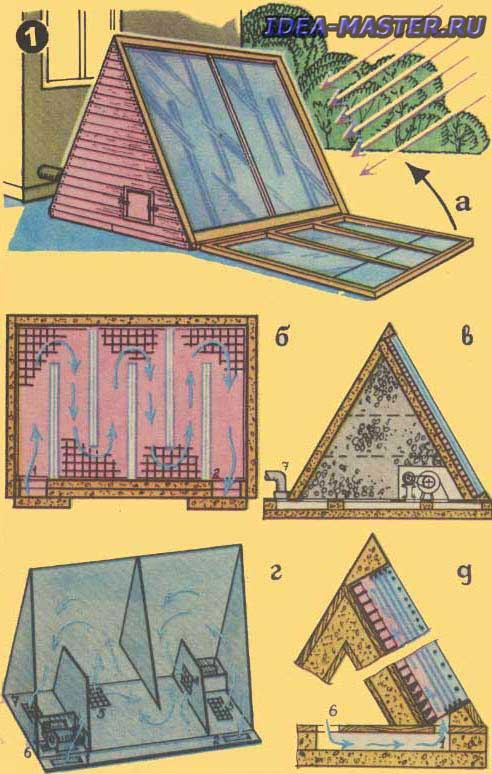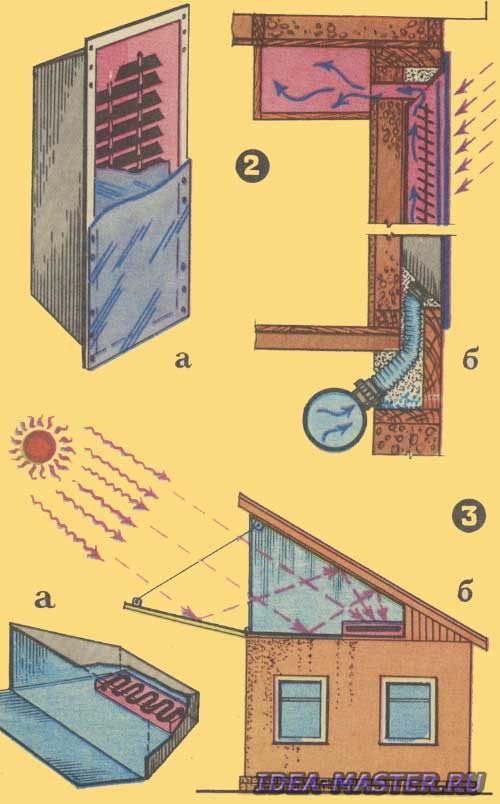Solar-powered heating system
It is estimated that a plane with an area of 36 sq. cm, facing perpendicular to the sun's rays, will receive so much energy per year that it will be enough to boil a kettle. You'll never drink tea like that... And why not try to «collect» scattered solar energy from a larger area and use it, for example, to heat a residential building?
Three variants of solar-powered heating installations
Today we will tell you about three heating installations. The first (see Fig. 1) can replace central heating batteries and even a Russian oven by its thermal power. Almost eight months a year, day and night, she is able to heat the premises of a large house. The round-the-clock operation is explained simply — its thermal power is so great (about 5 thousand W) that excess heat can be stored for future use, accumulated.

Figure 1a shows a general view of the heating system — we will call it a collector. It is built of wood and has a length of 350, a width of 180 and a height of 220 cm. A collector is installed on the south side of the residential building. You have noticed that there is a folding roof on the right side of the collector. During the day it is lowered, at night or during the rain it is raised. The roof protects the collector from heat loss and damage. The side wall of the collector is assembled from wooden frames and has triple glazing (see Fig. 1d). Both layers of air between the glasses are well insulated plates heated by sunlight. The plates themselves (see Fig. 1b, 1b and 1d) are made of strips of roofing iron and painted with black enamel. Heated by the rays, they give heat to the flow of air, which makes a difficult path through the maze between the cells and the inner glass. In Figure 1g, it is indicated by blue arrows.
The collector works like this. In the morning you threw back the roof and installed it at such an angle that the sunbeams from the mirrors fell on the black plates of the heater. When they heat up, turn on the fans 4 and 6. The air rushes through the hole 1 into the maze above the heater, heats up and exits into the hole 2. Through the hole 3, the fan directs it to the living quarters. The return flow returns to the collector through the hole 5. Then the flow is divided: part is sent back to the living quarters, and the other part is sucked in by the fan and goes to heating. Gradually, the air in the living quarters warms up to 24 °C, and if you want — even higher. If it gets hot, it is necessary to redistribute the air flows. The flap covers the duct through which warm air enters the house. Then most of it will begin to circulate inside the collector, heating the battery. An additional labyrinth is provided in the design of the accumulator, and the air gives more heat to the filler — a masonry of bricks or large stones laid with large cracks without a binder solution.
The mass of the battery is several hundred kilograms. By evening, the laying temperature reaches 75 °C. This accumulated heat is enough to maintain the indoor air temperature within 16-18 °C throughout the night. After sunset, the fan 6 is turned off and the roof of the collector is raised.
You can see a simpler collector design in Figure 2. Its dimensions are 150x100x10 cm, and the thermal power is 800 watts. The power is low, but it is enough to heat a room with an area of 12-14 sq. m. However, after sunset this installation does not work — it does not have a filler accumulating heat. To heat a larger area, several collectors can be made. They can work independently of each other or together. Then they should be connected to each other in parallel. The collector housing is made of roofing iron. Outwardly it resembles a trough (Fig. 2a), the inner surface of which should be painted black. Two rods are installed inside the case. They are wearing louver plates. They should also be cut out of roofing iron and painted with black enamel. The air from the room through a flexible sleeve (Fig. 2b) is fed by a fan into the collector, where it flows around the plates and heats up. To the heating system worked more efficiently, the front part of the collector has double glazing. The case is insulated with thermal insulation mats.

In the installation shown in Figure 3, it is possible to heat water. It is mounted in the attic under the roof. The sun's rays, repeatedly reflected from the mirrors installed on the side walls, ceiling and floor (see Fig. 3a), are concentrated into a narrow beam and fall on the coil installed in the box. The lid of this box (see Fig. 3b) has double glazing. In a similar way, you can heat water up to 70-80 °C and use it both for heating and for other household needs.
All materials of the section «Ideas for the master»
| Share this page on social networks: |
